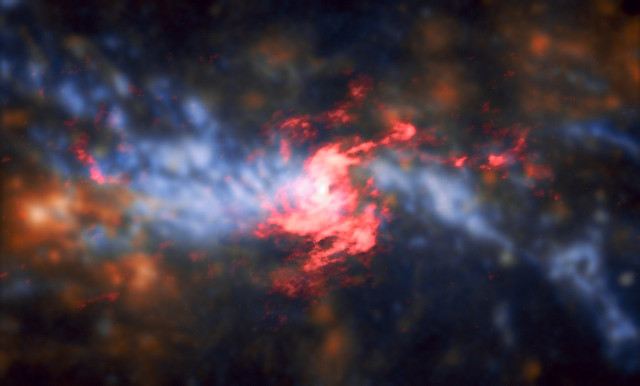
An image published by ESO and ALMA collaboration shows the center of the galaxy NGC 5643 obtained by combining observations made with the ALMA radio telescope with archive data of the MUSE instrument, mounted on ESO’s VLT. In this way it was possible to see beyond the clouds of dust and gas that obscure it even though it’s an active galactic nucleus with strong electromagnetic emissions generated by the activity of the supermassive black hole at the center of NGC 5643.
Approximately 55 million light years from Earth, the galaxy NGC 5643 is an intermediate spiral galaxy, halfway between a barred spiral galaxy and an unbarred spiral galaxy. It’s also classified as a Type 2 Seyfert galaxy, one of the largest groups of galaxies with an active galactic nucleus. Their luminosity doesn’t reach the level of quasars and allows to clearly detect the galaxies that host those nuclei.
Active galactic nuclei are generated by supermassive black holes surrounded by disks of materials that are slowly being swallowed and in the meantime get heated and ionized to the point of emitting electromagnetic radiation that may be even in the form of X-rays. Sometimes, however, that activity is concealed at least in part by clouds of gas and dust between the active galactic nuclei and the Earth so it the use of instruments that detect emissions passing through the clouds may be needed.
The ALMA (Atacama Large Millimeter/submillimeter Array) radio telescope, inaugurated in March 2013, is one of the instruments used for that type of task. In this case, they added archive data of MUSE (Multi Unit Spectroscopic Explorer), one of the instruments of the Very Large Telescope (VLT), which can split up the light of every point in the image into its components to create a spectrum. This combination made it possible to obtain an excellent view of the center of the galaxy NGC 5643 with energetic ionized gas outflows escaping into space.
Those enormous outflows extend on both sides of the galaxy NGC 5643 and are caused by the materials being ejected from the accretion disk around the central supermassive black hole. The combination of ALMA and MUSE data shows the central region with two distinct components: the spiral rotating disk, in red in the image, consisting of cold molecular gas traced by ionized oxygen and hydrogen, in blue-orange hues in the image, perpendicular to inner nuclear disk.
This type of investigation allows to obtain information on areas of space that are difficult to observe. In the case of galactic nuclei, it allows to understand the activity of the supermassive black holes at their center and to study their influence on the galaxies that host them. In particular, the influence on star formation is the subject of a lot of research in recent years thanks to instruments such as ALMA.


Permalink
Beautiful pic!
Permalink
Yes, those pics really put together science and art!